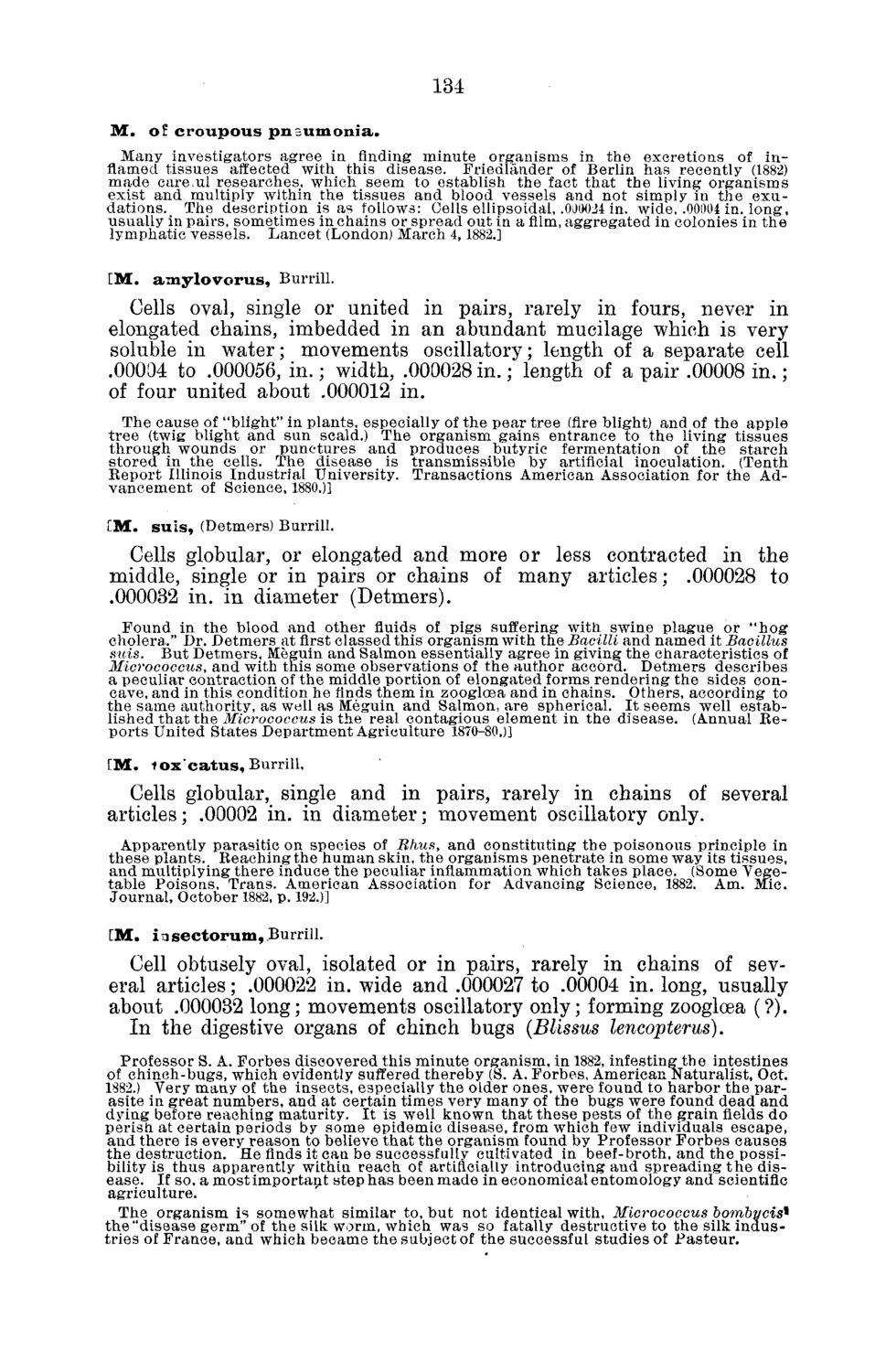| |
| |
Caption: Board of Trustees Minutes - 1882
This is a reduced-resolution page image for fast online browsing.

EXTRACTED TEXT FROM PAGE:
134 M . of c r o u p o u s p n e u m o n i a . Many investigators agree in finding minute organisms in the excretions of inflamed tissues affected with this disease. Friedlander of Berlin has recently (1882) made care.ul researches, which seem to establish the fact that the living organisms exist and multiply within the tissues and blood vessels and not simply in the exudations. The description is as follows: Cells ellipsoidal, .0i>(X)24 in. wide. .00004 in. long, usually in pairs, sometimes in chains or spread out in a film, aggregated in colonies in the lymphatic vessels. Lancet (London) March 4,1882.] [ M . a m y l o v o r u s , Burrill. Cells oval, single or united in pairs, rarely in fours, never in elongated chains, imbedded in an abundant mucilage which is very soluble in water; movements oscillatory; length of a separate cell .00004 to .000056, in.; width, .000028 in.; length of a pair .00008 in.; of four united about .000012 in. The cause of "blight" in plants, especially of the pear tree (fire blight) and of the apple tree (twig blight and sun scald.) The organism gains entrance to the living tissues through wounds or punctures and produces butyric fermentation of the starch stored in the cells. The disease is transmissible by artificial inoculation. (Tenth Beport Illinois Industrial University. Transactions American Association for the Advancement of Science, 1880.)] CM. s u i s , (Detmers) Burrill. Cells globular, or elongated and more or less contracted in the middle, single or in pairs or chains of many articles; .000028 to .000032 in. in diameter (Detmers). Found in the blood and other fluids of pigs suffering with swine plague or "hog cholera." Dr. Detmers at first classed this organism with the Bacilli and named it Bacillus suis. But Detmers, Meguin and Salmon essentially agree in giving the characteristics of Micrococcus, and with this some observations of the author accord. Detmers describes a peculiar contraction of the middle portion of elongated forms rendering the sides concave, and in this condition he finds them in zoogloea and in chains. Others, according to the same authority, as well as Meguin and Salmon, are spherical. It seems well established that the Micrococcus is the real contagious element in the disease. (Annual Beports United States Department Agriculture 1870-80.)] [ M . f o x c a t u s , Burrill, Cells globular, single and in pairs, rarely in chains of several articles; .00002 in. in diameter; movement oscillatory only. Apparently parasitic on species of Bhus, and constituting the poisonous principle in these plants. Beaching the human skin, the organisms penetrate in some way its tissues, and multiplying there induce the peculiar inflammation which takes place. (Some Vegetable Poisons, Trans. American Association for Advancing Science, 1882. Am. Mic. Journal, October 1882, p. 192.)] EM, i nsectorum, Burrill. Cell obtusely oval, isolated or in pairs, rarely in chains of several articles; .000022 in. wide and .000027 to .00004 in. long, usually about .000032 long; movements oscillatory only; forming zoogloea (?). In the digestive organs of chinch bugs (Blissus lencopterus). Professor S. A. Forbes discovered this minute organism, in 1882, infesting the intestines of chinch-bugs, which evidently suffered thereby (S. A. Forbes, American Naturalist, Oct. 1882.) Very many of the insects, especially the older ones, were found to harbor the parasite in great numbers, and at certain times very many of the bugs were found dead and dying before reaching maturity. It is well known that these pests of the grain fields do perish at certain periods by some epidemic disease, from which few individuals escape, and there is every reason to believe that the organism found by Professor Forbes causes the destruction. He finds it can be successfully cultivated in beef-broth, and the possibility is thus apparently within reach of artificially introducing and spreading the disease. If so, a most important step has been made in economical entomology and scientific agriculture. The organism is somewhat similar to, but not identical with, Micrococcus bombycis* the "disease germ" of the silk worm, which was so fatally destructive to the silk industries of France, and which became the subject of the successful studies of Pasteur.
| |